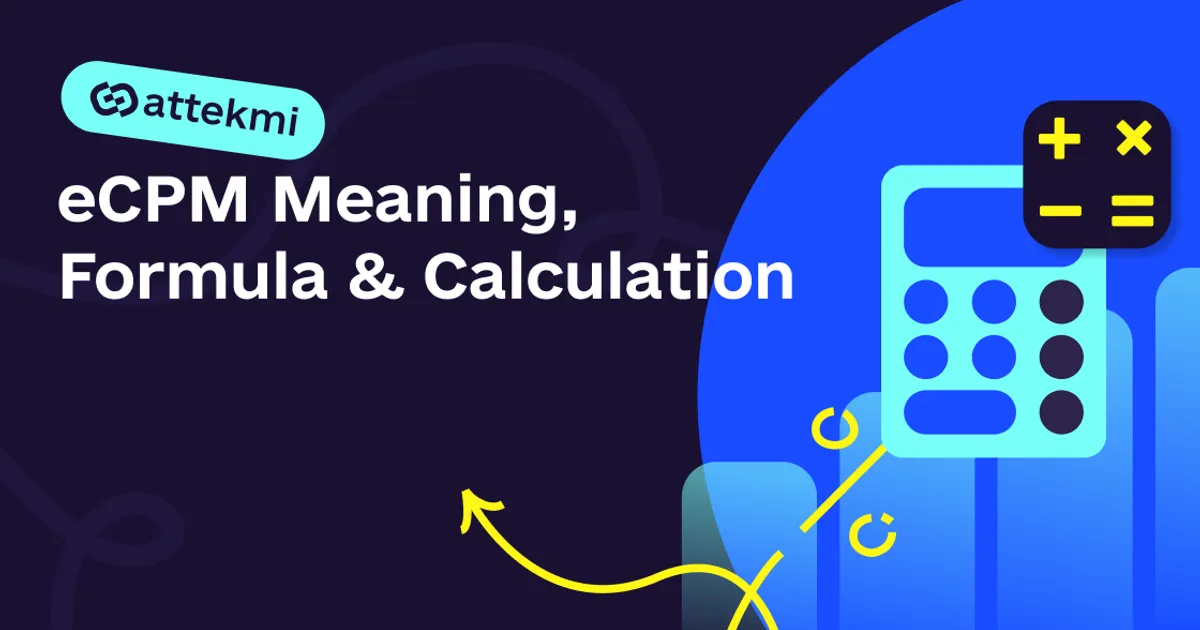There are multiple metrics that advertisers and publishers track to measure the performance of their campaigns and ad inventory, and eCPM is one of them. As an ad exchange owner, you should also be aware of the eCPM calculation formula. In this guide, we will explain why this metric is important to you, clarify its meaning, discover how to calculate it, and more.
What Is eCPM?
eCPM stands for effective cost per mille and should not be confused with CPM, which is simply cost per mille (or cost per thousand impressions). While CPM is also a type of buying model, eCPM is a metric indicating how much a thousand impressions earn.
Calculating eCPM is a must for publishers, as in this way, they understand how efficient and profitable the inventory is. Using this metric, they can ensure strategy and ad revenue optimization.
For marketers, CPM may seem to be a more important rate, as it measures the cost of delivering a thousand impressions. However, tracking eCPM allows them to understand the effectiveness of advertising campaigns. These insights can then be used for fine-tuning the campaigns and ads themselves.
3 Steps On How to Calculate eCPM
In short, the eCPM formula is as follows: the ad revenue must be divided by the number of ad impressions and then multiplied by 1000. Now, let’s review how to calculate eCPM in detail.
Calculating the Ad Revenue
First of all, it is essential to measure total ad earnings. To do this, publishers multiply how much they earn per ad by the number of ad units they sell. For instance, the price of every unit is $3, and 100 of them were sold within a day. This means that the total revenue is $300.
As for advertisers, they can use the total ad spend instead of ad revenue.
Dividing the Revenue
The next step is to divide the identified revenue by impressions. For example, 80k impressions were received during one day. Then, dividing $300 by 80,000 results in $0.00375.
Multiplying By 1000
Finally, the revenue per impression is multiplied by 1000 so publishers can figure out their revenue per thousand impressions. In our example, $0.00375 multiplied by 1000 is $3.75.
The formula is the same for publishers and advertisers; the only difference is that publishers use the ad revenue rate, while marketers use the amount of money they spent on a specific activity.

To simplify the calculation process, publishers and advertisers can use an eCPM calculator.
Key Factors Influencing eCPM
The eCPM value is affected by multiple factors. Here are the key ones.
Ad Format
Different advertising formats may have different eCPMs. For instance, video ads may cost more than standard banner ads. Therefore, they will be more expensive for advertisers but more profitable for publishers.
Ad Quality
High-quality ads, for instance, creative and memorable videos in high resolution, tend to be more appealing and engaging. They often have higher eCPMs than generic or low-quality advertisements.
Ad Targeting
Precise targeting is key to effective advertising, so ads that are well-targeted and address specific audiences usually show better eCPM rates.
Ad Placement
For publishers, it is also important to pay attention to the ad placement on their websites or apps, as ads that are easy to notice usually drive more income. For instance, these can be ads placed above the fold or pop-up advertisements.
Seasonality
Seasonality is another factor that can influence eCPM. For example, during holidays or special events like Black Friday, the competition for the publishers’ ad inventory often increases, which positively affects the eCPM rate.
Audience Reach
Publishers that target niche audiences often have higher eCPMs than those addressing general audiences. This happens because advertising to specific customers is usually more expensive than promoting something to everyone.
User Engagement
A website or app with a large base of loyal and engaged users usually has higher prices for ad inventory. As a result, its owner will earn more than publishers with low traffic.
Best Practices For Optimizing eCPM
Optimizing the eCPM rate is essential both for publishers and advertisers, so here are some recommendations for them to consider.
Join the Programmatic Ecosystem
Starting using a programmatic demand- or supply-side platform is one of the most effective ways for marketers and publishers to increase the eCPM rate. Applying multiple settings, advertisers can target exactly those users who are most likely to get interested in their ads. In turn, publishers deliver relevant advertisements to their visitors or users, which is good for their experience.
Experiment With Formats And Placements
It is also essential for marketers to try different ad formats, as some of them may drive better results than others. As for publishers, they should do the same, along with experimenting with ad placements. For instance, providing some ad space above the fold can lead to higher eCPMs.
Set Up Targeting
Advertisers also need to apply all the available targeting settings. Yes, the ads will reach smaller audiences, but these users will be more likely to convert.
Improve User Experience
While advertisers should create high-quality ads, publishers need to ensure a good user experience. For example, it may be essential to increase the website speed or make it mobile-friendly. Besides, it is important to prioritize the quality of ads over their quantity.
Optimize For SEO
Publishers also need to optimize their websites for SEO to drive quality organic traffic. More visitors mean more opportunities, which will help increase eCPM.
Consider Using Attekmi Solutions
As an owner of an ad exchange, you need to assist publishers and advertisers in terms of optimizing their eCPMs, as this will have a positive impact on your income. With Attekmi solutions, this is simple since they come with the following features and opportunities:
The platform supports multiple traffic types, including desktop, in-app, mobile web, and CTV;
There are a variety of ad formats: banner, native, video, audio, pop, and CTV ads;
You can apply numerous filters and settings to match DSPs and SSPs effectively;
It is possible to integrate fraud detection tools for your SSP and DSP partners to ensure only genuine traffic, clicks, and impressions.
With Attekmi, you can start media trading quickly and maximize your revenue with the adaptive margin feature. For instance, StreamKey managed to double its profit within only two months.
In case you need a specific feature for driving higher eCPMs that is currently missing on the platform, feel free to opt for our White Label Ad Exchange, which is a fully custom platform.
To Conclude
Publishers and advertisers aim for high eCPMs, so ad exchange owners should do everything possible to help them reach their goals. Obviously, you cannot optimize the publisher’s website and make it mobile-friendly, but you can offer different ad formats and other features.
Note that there is no need to build an ad exchange from scratch. You can leverage a white-label platform that will start operating within a week or a bit more. This is the way to reduce production time and costs since all the essential features are already integrated.
Try Attekmi solutions to ensure high eCPM rates for your publishers and advertisers!
FAQ
How is eCPM calculated?
Here is the eCPM formula: the total advertising revenue (or ad spend for advertisers) is divided by the total number of ad impressions. Then, the result is multiplied by 1000. Using an effective cost per mille calculator is the way to simplify the calculation process.
Is a higher eCPM rate always better?
A high eCPM means that ads are effective and drive conversions. Publishers earn more, while advertisers know that their ads are bringing results. To drive income, ad exchange owners have to provide both marketers and publishers with the conditions essential for reaching high eCPMs.
Do I need to calculate eCPM as an ad exchange owner?
No, but you have to ensure that advertisers and publishers connecting via your platform can reach high eCPM rates. Set up endpoints for your SSP and DSP partners to match them effectively, ensure the variety of ad formats and traffic types, apply filters, and integrate fraud detection tools.
 By Anastasiia Lushyna
By Anastasiia Lushyna